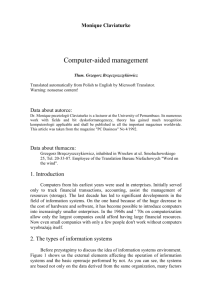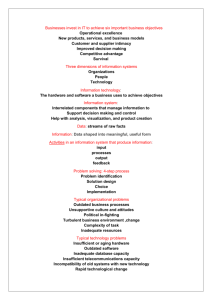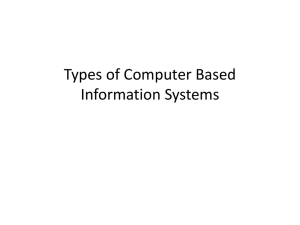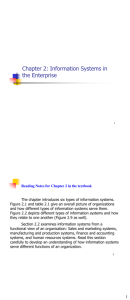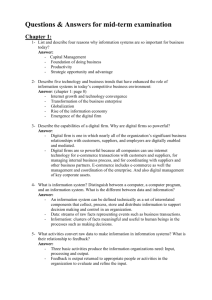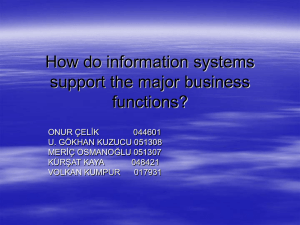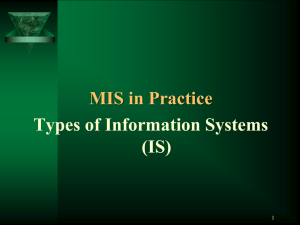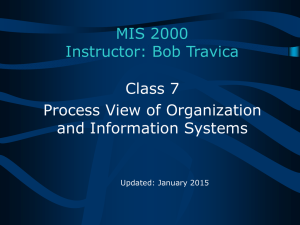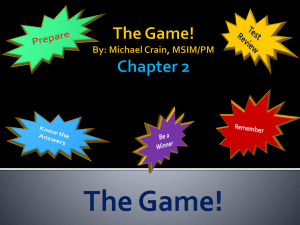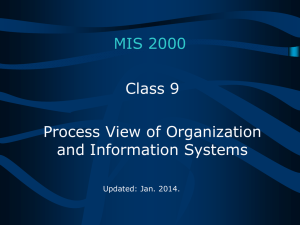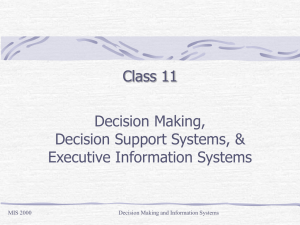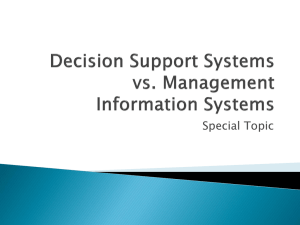Introduction to Information Systems
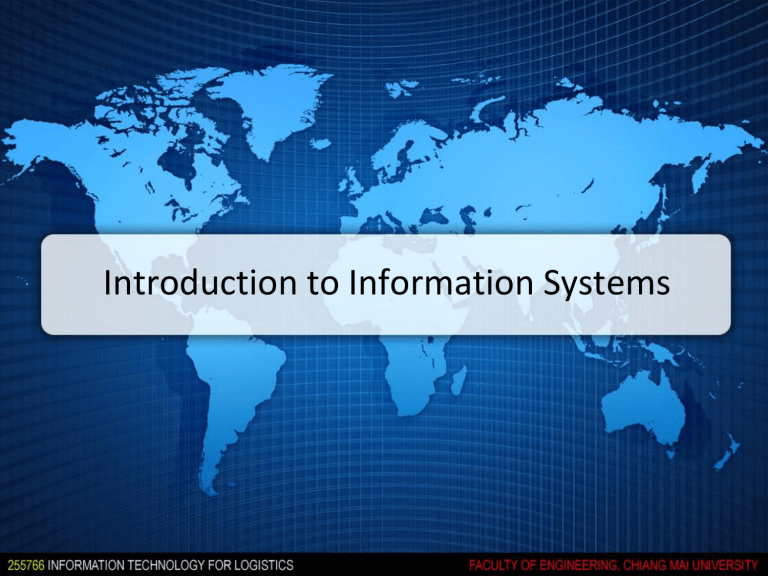
Introduction to Information Systems
Data, Information and Knowledge
How do “ Information ” differ from “ Data ”?
There is also things such as “ Knowledge ”.
How are they related?
Data, Information and Knowledge
Data
Transformation Process
(selecting, organizing, manipulating)
Information
Practical Use
Knowledge
Translating Data to Information
Grouping
Lebelling
Sorting
Graphing
Statistics
Etc.
Data
1600
1612
1615
1659
1708
1722
1723
1730
2201
In
1631
1625
1725
1734
1812
1751
1749
1815
2240
Out Customer
1 M
1 F 1 M
4 M
1 F
2 F 1 M
1 F 2 M
1 M
1 M
1 M
Order
1 Chocolate
2 Strawberry, 1 Coconut
2 Chocolate, 1 Lemon,
2 Strawberry, 1 Banana
3 Coconut
1 Chocolate, 1 Vanilla,
1 Coffee
3 Coffee, 1 Wafer
1 Coconut, 1 Chocolate, 2
Strawberry
2 Vanilla
1 Coffee
Income
20.-
60.-
105.-
60.-
60.-
70.-
80.-
40.-
20.-
Customers
12 Male
-
5 Female
Peak period
1600-1815
Income
515.-
Payment
300.-
Financial statistics
1 day + 10%
1 week + 20%
1 month + 20%
Information
Popular menu
Strawberry - 6 (7, 2, 4, 6, 8)
Vanilla - 6 (10, 5, 8, 7, 6)
Chocolate - 5 (4, 7, 4, 5, 5)
Coconut
-
5 (6, 2, 9, 6, 7)
Unpopular menu
Lemon - 1 (0, 0, 0, 1, 0)
Guava - 0 (0, 0, 1, 1, 0)
Red bean - 0 (0, 0, 0, 0, 0)
Knowledge
Promote and stock more strawberry and chocolate
Terminate guava, red bean and lemon menu
Change closing time to 1900
Replace the male staff
System
A set of elements or components that interact to accomplish goals
Components of A System
Inputs
Processing mechanisms
Outputs
Feedback
Concept of A System
Input
Processing
Feedback
Output
Performance of A System
Efficiency
Proportion of outputs and inputs
Effectiveness
Achievement of objectives
Class 1
Performance of A System
Class 2 Class 3
F D C B A
Efficiency – OK
Effectiveness – OK
F D C B A
Efficiency – Poor
Effectiveness – OK
F D C B A
Efficiency – Good
Effectiveness – ?
Information Systems
A set of interrelated components that collect, manipulate, and disseminate data and information, and provide feedback to meet an objective (Stair & Reynolds, 2010)
Complementary networks of hardware and software that people and organizations use to collect, filter, process, create and distribute data (Wikipedia, 2014)
Components of An Information System
Inputs Process Outputs
Feedback
Inputs
Gathering and capturing of raw data
Processing mechanisms
Converting data into useful outputs
Outputs
Useful information
Feedback
Information that is used to make changes to the input and processing components
Concept of An Information System
Data
Information
System
Information
Components of
Computer-Based Information Systems
Hardware
Software
People
Telecommunications
Databases
Procedures
Development of Business Information Systems
TPS
Transaction
Processing
System
MIS
Management
Information
System
DSS
Decision
Support
System
Specialized business information systems
&
Electronics
Commerce
&
Inter-Organization information exchange systems
Types of Internal Information Systems
Executive
Support
Systems
(ESS, EIS)
Decision
Support
Systems
(DSS)
Management
Information
Systems
(MIS)
Office
Automation
Systems
(OAS)
Transaction
Processing
Systems
(TPS)
Types of Internal Information Systems
IS Inputs
ESS Aggregate data,
External, internal
DSS Low volume data,
Analytic models
MIS Transaction data,
High volume data
OAS Office documents,
Schedule
TPS Transaction,
Events
Processing
Graphics,
Simulation
Interactive,
Simulation
Routine report
Word processing,
Storage
Sorting,
Listing
Outputs
Projections
Special reports,
Decision analyses
Summary,
Exception reports
Documents,
Schedule
Detail report,
List
Users
Senior management
Staff manager
Middle manager
Managers
Operation personnel
Transaction Processing Systems (TPS)
ระบบประมวลผลรายการเปลี่ยนแปลง
A software system, or software/hardware combination, that supports transaction processing (Wikipedia, 2014)
Features
Rapid response
Reliability
Inflexibility
Controlled processing
Example
Point-of-Sale
Library loan
TPS: Examples
Office Automation Systems (OAS)
ระบบส านักงานอัตโนมัติ
Varied computer machinery and software used to digitally create, collect, store, manipulate, and relay office information needed for accomplishing basic tasks (Wikipedia, 2014)
Example
Work flows
Project scheduling
OAS: Examples
Management Information Systems (MIS)
ระบบสารสนเทศเพื่อการจัดการ
A system which provides information that organizations require to manage themselves efficiently and effectively (Wikipedia, 2014)
Example
Flight information system
Student information system
MIS: Examples
Decision Support Systems (DSS)
ระบบสนับสนุนเพื่อการตัดสินใจ
A system that supports business or organizational decision-making activities
(Wikipedia, 2014)
Example
Price evaluation system
Potential drilling sites
DSS Examples
Executive Support Systems (ESS)
ระบบสนับสนุนผู้บริหารระดับสูง
Also-called Executive Information Systems (EIS)
A type of management information system that facilitates and supports senior executive information and decision-making needs (Wikipedia, 2014)
Example
Market and sales analysis system
A.C.M.E (Agent Call Monitoring & Evaluation)
ESS: Examples
Structure of An Information System
Source: http :// blog .
maia intelligence .
com / wp content / uploads / 2008/04/042908-1415-functionalm2 .
png
Enterprise Resource Planning (ERP)
ระบบการวางแผนทร ัพยากรองค ์กร
A business management software that a company can use to collect, store, manage and interpret data from many business activities (Wikipedia, 2012)
Examples of ERP Packages
Tier I
SAP
Oracle
Microsoft Dynamics
Tier II
Epicor
Sage
QAD
Ross
Tier III
ABAS
Baan
Syspro
Source: Panorama Consulting Group, 2014, http://go.panorama-consulting.com/rs/panoramaconsulting/images/2014-Manufacturing-ERP-Report.pdf
ERP Statistics
(See Panorama Consulting Group Report 2014)
Costs of Implementing ERP Packages
Vendor
Oracle
SAP
Microsoft Dynamics
Tier II
Tier III/Other
Average Project Cost
$5.0 million
$6.7 million
$1.8 million
$3.1 million
$1.1 million
Source: Panorama Consulting Group, 2010 http://panorama-consulting.com/Documents/2011-Guide-to-ERP-Systems-and-Vendors.pdf
SAP Tryout!
SAP Online Configurator: https://www.sapconfigurator.com/sapcfg/build/index.html?l
ang=en&campaign=CRM-US08-HUB-TC_FSTWEB&cntry=us
Specialized Business Information System
Knowledge Management System (KMS)
Organized collection of people, procedures, software, databases, and devices to create, store, share, and use the organization’s knowledge and experience
Artificial Intelligence (AI)
Computer system takes on characteristics of human intelligence
Specialized Business Information System
Expert Systems
Give computer ability to make suggestions and function like an expert in a particular field
Virtual reality
Simulation of a real or imagined environment that can be experienced visually in three dimensions
Augmented reality
Electronics Commerce
Often called as “e-Commerce”, “eCommerce”,
“e-comm” or “e-Business”.
Trading in products or services using computer networks, such as the Internet
(Wikipedia, 2014)
Information Systems in the Supply Chain
Raw materials
Inbound logistics/
Warehouse/
Storage
Production
ACTIVITIES
Packing/
Outbound logistics Customer service
Supplier
Purchasing Production Distribution
Internal Supply Chain
Customer
Supplier database
INFORMATION SYSTEMS
Inbound tracking system/
Inventory control
Process control system
Automated packing and retrieval system system
Customer service tracking and control system
Functions of Information Systems in
Logistics
Collaborative planning
Forecasting
Inventory management
Order management
Transport management
Etc.
Challenges
Standards
Culture and language
Time and distance
Technology and infrastructure
Currency and exchange rates
Laws and legal aspects
Privacy, permission and confidentiality
In-Class Assignment
Critical Thinking
Form four groups
Discuss and criticize connections between the following challenges and information systems in Thailand
Group 1
Laws
Group 2
Culture
Group 3
Infrastructure
Group 4
Language
Three minutes presentation
Assignment
Information Engineering
Spilt into four groups.
Build a Facebook page with an objective of anything .
Promote your page. Aim for the highest likes as possible.
Present your strategy on 25 September 2014.
